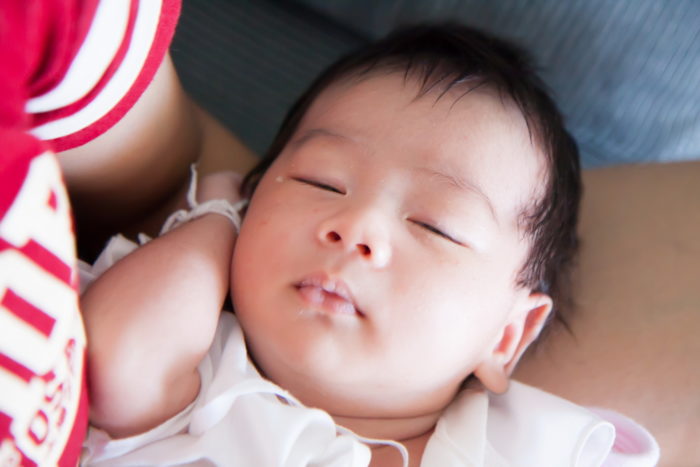By Dr. Andrew Mower, CHOC neurologist
You open the exam room door to find an anxious mother pacing with her baby. Her son has been displaying sudden shivering moments, she says. She’s frightened that these episodes were epileptic seizures.
Indeed, watching a child shake and tremble suddenly is worrisome for any parent. But not every paroxysmal event is a seizure or neurological event.

Here are 11 such examples, and a guide to help pediatricians understand what the differential diagnosis is for seizures and other neurological events; recognize elements in the history that helps differentiate whether the paroxysmal spell is a seizure or neurological event or not; and learn what initial diagnostic workup is needed to guide management.
1. Breath holding
During these episodes, a child appears to stop breathing and may collapse, typically after a startling, frustrating or painful event. The child’s skin may be pale or purple in color, and he may show mild tonic or tonic-clonic movements. Recovery occurs in minutes. The behavior surfaces typically in children between ages 6 months and 2 years.
Though they may appear to be a seizure, these episodes are a physiological response, and not caused by electrical impulses in the brain.
Some factors to consider, however, that would call into question whether this is something other than breath-holding spells include a questionable or unclear trigger, progressively more frequent episodes, movements much more suggestive of a seizure, a very young age of onset, and a child with a developmental delay.
Children showing these red flags may require an EEG. For most, however, a workup is not typically needed, nor is treatment.
Almost all children outgrow breath holding and there is no neurological consequence.
2. Benign paroxysmal vertigo
During these episodes, a child, typically between 1 to 2 years of age, may become suddenly unsteady and fall. The child may become pale, vomit or cry, but retain consciousness. Events last minutes.
These events are considered an early migraine manifestation. Differential diagnoses include labyrinthitis, CNS tumor, epilepsy, unwitnessed head trauma and concussion, near-syncope, cardiac dysrhythmia
More worrisome are events that are unremitting and not episodic; include a loss of consciousness; show other neurological signs such as seizures, weakness or hearing loss; or are experienced by a child with a developmental delay can be more worrisome.
Workup for children exhibiting these events could include a brain MRI, ENT evaluation or EEG.
These episodes are typically not progressive or degenerative, but do indicate a likelihood for migraines in teen and adult years.
3. Shuddering attacks
Patients experiencing these events have shivering moments that last seconds, which can occur sporadically or multiple times a day. They occur most typically in infants ages 6 to 15 months, and they do not lose consciousness.
These events are behavioral, and differential diagnoses include seizure or tics.
Longer episodes; rhythmic twitching; a change of awareness or consciousness; and color change are red flags, as is an event experienced by a child with developmental delay or abnormal exam.
A video captured at home is often sufficient for diagnosis, and no workup is needed. No treatment is necessary for these events, and a child’s prognosis is excellent.
4. Infant gratification
This is a normal phenomenon, more commonly known as masturbation, that can include dystonic posturing, grunting, rocking, eidetic imagery and sweating. Typically experienced by children 2 months to 5 years of age, these events can occur sporadically or multiple times a day.
Children’s skin may change color and they may seem tired afterward. The event can be stopped in progress, but a child may get upset if the parents stop the behavior.
Red flags for this behavior include unresponsiveness, tonic-clonic movements or cyanosis, and a differential diagnosis is partial seizures.
A video captured at home is often sufficient for diagnosis, and no workup is needed. Treatment is behavioral based, and prognosis is excellent.
5. Staring spells
These episodes occur in children of any age, but are common in children with autism. The spells may look like day dreaming or inattention, but are often redirectable.
Often, the events are behavioral or related to frontal lobe processing. Differential diagnoses include absence or complex partial seizures. Episodes wherein children are not redirectable, show a change in coloring or behavior, or have a cognitive decline are more worrisome.
Workups include EEG, ADHD evaluation, neuropsychological evaluation for learning disabilities and cognitive abilities, or a psychological evaluation.
Treatment can include psychology or behavioral therapy, neuropsychology and appropriate educational setting, or stimulant medication as needed.
In general, a child’s prognosis is typically excellent. Children with ADHD have a generally good prognosis, but may have variable response to treatment with stimulant medications. A prognosis for those with learning disabilities depends on the severity, classroom setting and educational factors.

6. Reflux
Shown in younger infants from birth to age 6 months, these events look like twisting and writhing movements that aren’t typically sudden. However, patients may show some sudden flexion and extension of the body, arms or legs. Children’s skin may redden.
Children exhibiting these events may have low muscle tone that contributes to relaxed muscle at esophageal-gastric junction.
Differential diagnoses include seizures, infantile spasms or movement disorders, and red flags include no association with feeding, stereotyped movements like jack-knifing or sudden flexion in clusters, or cyanosis.
Workup includes clinical diagnosis, further investigation following a finding of low tone on exam, sometimes upper GI or other GI studies, EEG or video-EEG monitoring.
Treatment includes H2 blockers or proton pump inhibitors.
Patients’ prognoses are generally excellent with symptoms resolving over time. However, for children with significant GI pathology or neuromuscular conditions, the prognosis is guarded.
7. Tics/Tourette’s syndrome
These episodes include the twitching of one muscle or a group of muscles, but rarely involve larger muscle groups. Though repetitive, they are not typically rhythmic or prolonged. They do not cause falling, and do not typically restrict activities.
They can occur in a variety of ages, and older children may describe a feeling that they must make the movement. Vocal tics include grunting, humming, clicking and sniffling, but rarely formed words.
As pathophysiology, structural and functional neuroimaging studies have shown the involvement of the basal ganglia and related cortico-striato-thalamo-cortical circuits, and the dopaminergic neuronal system.
Differential diagnoses include myoclonic seizures. A change of consciousness, inability to suppress, onset in sleep, and episodes that are rhythmic and repetitive are red flags.
Workup includes a clinical diagnosis, EEG or screening for the presence of ADHD, OCD or other behavioral disorders.
Most children do not need treatment for tics, unless the behavior is disturbing physically or socially. Central alpha agonist medications (Clonodine, Tenex) or dopamine antagonist drugs (Haldol, Risperdal, ORAP, Pimozide) can be useful.
Most children outgrow tics, and up to 15 percent of people diagnosed with Tourette’s outgrow the condition.
8. Stereotypies
Typically shown in early childhood after age 1, these episodes are marked by repetitive stereotyped movements that may or may not be rhythmic. They are self-stimulatory and otherwise without purpose. Examples include hand flapping or rocking. Events may persist into adulthood, especially in patients with autism or an intellectual disability.
These events are behavioral in nature, but a differential diagnosis is automatisms with complex seizures.
Red flags include a change in awareness, which can be difficult to detect in children with autism, and events that are rhythmic and repetitive.
Workup includes and EEG, and treatment is applied behavior analysis or therapy from a psychologist. For children who can be taught not to exhibit the behavior, prognosis is good.
9. Night terrors
These episodes are more common in children around age 3, but can surface earlier and persist into teenaged years and adulthood.
A patient may awake from deep sleep with a terrified look, screaming and showing decreased responsiveness. They may tremble, and episodes may occur several times a night.
Their exact mechanism is unknown, but night terrors may be genetic.
Differential diagnoses include nightmare, seizure, arousal disorder or parasomnia. Episodes are more worrisome if they occur many times a night, include strange repetitive movements like pelvic thrusting or bicycle pedaling motions, or are accompanied by progressive academic or developmental decline.
Workup includes a history and clinical diagnosis, polysomnogram or video EEG sometimes combined with polysomnogram.
Most children grow out of night terrors and do not require treatment, but can benefit from counseling on sleep habits or psychology. Though rarely, medications like clonazepam or amitriptyline can be helpful.

10. Syncope
These events are more common in teenaged patients. They include a sudden and brief loss of consciousness typically with associated loss of muscle tone. Patients may fall or slump forward or backward, and have mild twitching. They might also have a light-headed, giddy feeling or blackening of vision.
Loss of consciousness lasts only seconds, and patients may hear people around them before vision returns. They may feel groggy afterward, but not confused.
Recovery is quick, and episodes typically have a trigger: standing up too quickly, standing in place too long with legs locked, dehydration on a hot day, emotional fright, valsalva including defecation or urination, hair traction, or venipuncture.
These episodes are not a primary neurological event, and a common feature is reduced cerebral perfusions. They stimulate the vagus nerve, which causes bradycardia. Decreased venous tone allows venous pooling and decreased blood return to the heart. Valsalva prevents venous return to heart
Differential diagnoses are complex partial or other types of seizures, or postural orthostatic tachycardia syndrome.
Red flags include no provoking factor, prolonged and prominent tonic-clonic movements or hemi-clonic movements, cyanosis, or occurrence in very young children or those with a neurological or developmental disorder.
Workup includes diagnosis based on clinical history; orthostatic blood pressures; EEG if any red flags are present; and KG/Holter study, tilt-table testing, or cardiology consult if the patient’s clinical history is suggestive of dysrhythmia.
Treatment includes counseling on how to avoid symptoms, including standing up slowly, drinking water and avoiding triggers.
Looking forward, a predisposition to fainting may continue into adulthood. The episodes don’t cause neurologic injury, but a patient could get injured from a fall.
11. Cyclic vomiting
These episodes entail one to five days of copious vomiting, followed by asymptomatic periods. The average age of patients is 5, but episodes can span from infancy to adulthood.
They usually start in early morning or late afternoon. Abdominal pain, anorexia, lethargy, pallor, sweating and salivation accompany the episodes.
Triggers include emotional stress, energy-depleting states, some foods and menstrual cycles.
To diagnose, the patient must have stereotypic episodes of vomiting with at least two acute-onset episodes in the past six months, each occurring at least one week apart and persisting for less than one week.
Red flags include periods of unresponsiveness, tonic-clonic movements, visual changes, other neurological symptoms such as hemiparesis, hematemesis and melena.
Workup includes MRI or GI referral and endoscopy.
IV fluids, anti-nausea medication, pain relief medication is common treatment. Periactin; amitriptyline; antiepileptic medications with migraine indications (Depakote, Topamax, others); and propranolol can be used as prophylactics.




